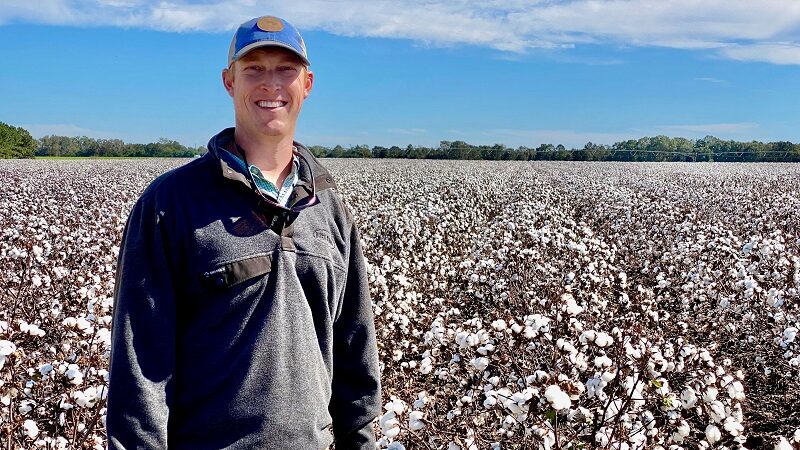Crop Scan AgReport – Managing a Good, but Behind Schedule, Crop
Cotton Grower® magazine’s Crop Scan AgReport for mid-July shows growers continuing weed, insect and crop management in a crop that – overall – is in good shape but still running behind.
Wes Briggs is an independent consultant providing recommendations on weed, disease, insect and fertility management, plus variable rate soil sampling, for growers in Georgia, Alabama and Florida for more than 30 years. He and his scouting team cover about 10 counties in the tristate area, checking cotton, corn, peanuts, soybeans and some small grains.
Over the last two weeks, we’ve gotten more than our fair share of rainfall. Some areas have received rain 12 out of the last 14 days with amounts totaling 2 to 9 inches in spots. Weed control and fertilizer have taken priority. We’ve only managed 2 to 3 workdays in the last two weeks because it’s rained everyday somewhere. We are addressing weed and fertility issues across the board in cotton, soybean, and peanuts.
The majority of the corn has black layered, and cotton ranges from eight-leaf to third week bloom. We are experiencing more crop injury in cotton than I can remember from our herbicide sprays over-top. Conditions have been ideal for crop injury. Soil moisture, temperature and humidity play a huge role in herbicide/crop interactions. Challenging would be an understatement so far in 2021.
To date there has been no bollworm movement in Bollgard II cotton, and we are picking up corn earworm moths. Nematodes, stinkbugs, plant bugs and spider mites are our primary focus for the next 2 to 3 weeks in cotton. Older cotton has been sprayed two to three times for these pests. Plant bugs have been a major problem.
We’ve seen very little to no target spot in cotton so far. It takes both heat and moisture to drive this disease, and we have both. The lack of fungicides may become an issue this year if target spot becomes issue. In a nutshell, fruit retention in cotton is below average on 50% to 60% of the crop for several combined factors. We need some dry sunny days to catch up. We haven’t missed this crop yet. We just have some catching up to do!
Chad Harrell owns and operates Harrell Agronomic Services in Northeastern North Carolina. He is a member of the North Carolina Agricultural Consultants Association and serves on the board of the North Carolina Cotton Producers Association.
Cotton is progressing nicely. The early planted cotton now has quarter-sized bolls that we can assess for stink bug damage. Our main focus now is on lygus control and PGR applications.
Since last update, lygus pressure has really increased in our area with many fields reaching treatment levels. I think we are still a couple of weeks off from our major moth flight.
We have decent moisture now and are expected to receive around an inch of rain this week.
Tucker Miller is a Mississippi-based independent private consultant for cotton, soybeans, corn, peanuts, rice, and vegetables. He is a member and past president of the Mississippi Agricultural Consultants Association.
Cotton ranges from 13-19 nodes. Most cotton is in full bloom, but some is just now starting to bloom.
Plant bugs are still pouring out of the corn pretty heavy, and we have put out a second application on a lot of the cotton. Aphids and spider mites have both been spotty and have been treated as necessary. We are starting to see an increase in bollworm eggs and just treated the Bollgard II cotton on some places.
We have been adding PGRs where needed, which has been tricky this year with many bottoms being stunted from flooding. We will continue monitoring the egg lay in Bollgard II varieties and are relying on the Bollgard 3 to stay effective. Just about everywhere got a much-needed rain this weekend.
Mark Nemec is a Texas independent agricultural consultant, now in his 27th year of checking cotton, wheat, grain sorghum and corn in the Blacklands and Brazos River Bottom area of Central Texas.
Most of the cotton in Central Texas is in full bloom. The area continues to get rains and cooler than normal weather. We are having some issues with fruit shed due to the continued cloudy days and rain in the area. PGRs are going out fast as we can and at higher rates than normal. But with all the mud, the crop dusters are backed up several days.
There have been a few weed issues in spots that need to be addressed as soon as we can get in the field. For the most part, growers have done a good job controlling weeds this year.
Luckily, insect pressure has been relatively light so far. Isolated stink bugs are starting to appear in some fields and need to be watched closely as our grain crops are drying down and getting ready to be harvested. Bollworm numbers have been surprisingly low so far this summer. We are in a watch and hold pattern for now.
Kerry Siders is Texas A&M AgriLife Extension Agent-IPM for Hockley, Cochran and Lamb Counties, providing education and applied research for weeds, insects, diseases, nematodes, growth regulators and harvest aids in cotton. He is a member of the High Plains Association of Crop Consultants.
We have been through the wringer the last several weeks here on the Southern High Plains of Texas. My prayer now is that we have good open weather from here on out with gentle, timely rains and a great long fall. On the bright side, we have good soil moisture for mid-summer, and the temperatures are generating good heat units.
Based on the IPM scouting program fields here is what our average upland cotton plant looks like:
- Average number of total nodes is 13 (range 6 to 16)
- 1st fruiting branch at node 7 (range 5-9)
- Square retention of 1st positions is 91% (range 67-100%)
- Node length is 0.9″ (range of 0.4″-1.8″)
- Plant populations average 32,650 per acre (range 17,300 to 48,000)
- Nodes above white flower 9 (only one field has started to bloom)
I began finding blooms on July 16. I project we should go into bloom with 8.5 nodes above white flower. This places first bloom on early fields, which have escaped much weather damage, near July 24. The remaining fields should be at or near first bloom hopefully before August 1. Recall that August 20 is the date when we say with some confidence that a boll formed on that day will have time to mature out. Anything formed after that point, the odds of it having time to mature decreases greatly.
My priority list for the rest of July:
- Keep close watch on fleahoppers and Lygus, especially on young squaring cotton.
- Scout for aphids and larvae pests on blooming cotton.
- Stay on top of weed control – cultivate, hoe, whatever it takes to keep the pigweed from going to seed. It is a numbers game.
- If you still have fertilizer to go out, get it in place before the end of this month. This applies even to late cotton. Late fertilizer applications will only delay maturity and can encourage cotton aphids.
- Look at the top 3 to 4 nodes on your cotton. If the internode length is longer than 1.5″, consider a plant growth regulator.















